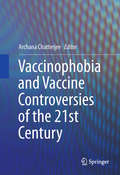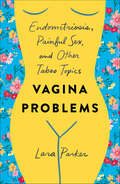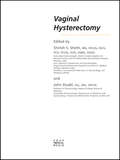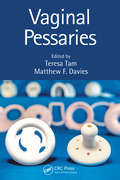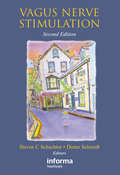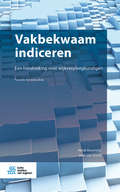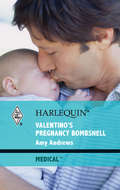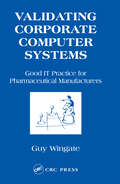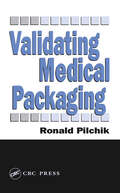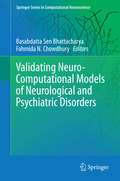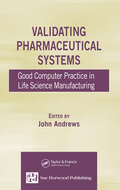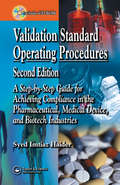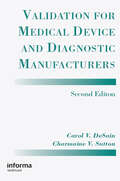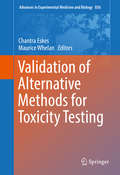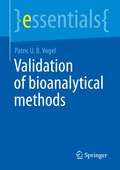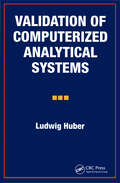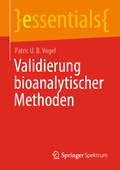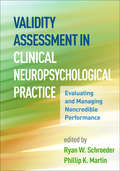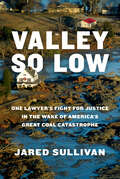- Table View
- List View
Vaccinophobia and Vaccine Controversies of the 21st Century
by Archana ChatterjeeVaccinophobia and Vaccine Controversies of the 21st Century Archana Chatterjee, editor Once hailed as a medical miracle, vaccination has come under attack from multiple fronts, including occasionally from within medicine. And while the rates of adverse reactions remain low, suggestions that vaccines can cause serious illness (and even death) are inspiring parents to refuse routine immunizations for their children--ironically, exposing them and others to potentially serious illness. Vaccinophobia and Vaccine Controversies of the 21st Century explains clearly how this state of affairs came into being, why it persists, and how healthcare professionals can best respond. Current findings review answers to bedrock questions about known adverse events, what vaccine additives are used for, and real and perceived risks involved in immunization. Perspectives representing pediatricians, family practitioners, nurses, parents, pharmacy professionals, the CDC, and the public health community help the reader sort out legitimate from irrational concerns. In-depth analyses discuss the possibility of links with asthma, cancer, Guillain-Barre syndrome, SIDS, and, of course, autism. Included in the coverage: Communicating vaccine risks and benefitsThe vaccine misinformation landscape in family medicinePerceived risks from live viral vaccinesThe media's role in vaccine misinformationAutoimmunity, allergies, asthma, and a relationship to vaccinesVaccines and autism: the controversy that won't go awayThe conundrums described here are pertinent to practitioners in pediatrics, family medicine, primary care, and nursing to help families with informed decision making. In addition, Vaccinophobia and Vaccine Controversies of the 21st Century should be read by trainees and researchers in child development and maternal and child health as the book's issues will have an impact on future generations of children and their families.
Vagina Obscura: An Anatomical Voyage
by Rachel E. GrossA myth-busting voyage into the female body. A camera obscura reflects the world back but dimmer and inverted. Similarly, science has long viewed woman through a warped lens, one focused narrowly on her capacity for reproduction. As a result, there exists a vast knowledge gap when it comes to what we know about half of the bodies on the planet. That is finally changing. Today, a new generation of researchers is turning its gaze to the organs traditionally bound up in baby-making—the uterus, ovaries, and vagina—and illuminating them as part of a dynamic, resilient, and ever-changing whole. Welcome to Vagina Obscura, an odyssey into a woman’s body from a fresh perspective, ushering in a whole new cast of characters. In Boston, a pair of biologists are growing artificial ovaries to counter the cascading health effects of menopause. In Melbourne, a urologist remaps the clitoris to fill in crucial gaps in female sexual anatomy. Given unparalleled access to labs and the latest research, journalist Rachel E. Gross takes readers on a scientific journey to the center of a wonderous world where the uterus regrows itself, ovaries pump out fresh eggs, and the clitoris pulses beneath the surface like a shimmering pyramid of nerves. This paradigm shift is made possible by the growing understanding that sex and gender are not binary; we all share the same universal body plan and origin in the womb. That’s why insights into the vaginal microbiome, ovarian stem cells, and the biology of menstruation don’t mean only a better understanding of female bodies, but a better understanding of male, non-binary, transgender, and intersex bodies—in other words, all bodies. By turns funny, lyrical, incisive, and shocking, Vagina Obscura is a powerful testament to how the landscape of human knowledge can be rewritten to better serve everyone.
Vagina Problems: Endometriosis, Painful Sex, and Other Taboo Topics
by Lara Parker“In Vagina Problems…Lara Parker unpacks the personal and economic costs of endometriosis.” —Vanity Fair“A refreshingly honest read about living with chronic pain.” —Hello GigglesWith unflinching honesty, Lara Parker, the Deputy Director for BuzzFeed, shares her day-to-day challenges of living, working, and loving with chronic pain caused by endometriosis in this raw, darkly humorous, and hopeful memoir.I wasn’t ready to be completely honest about my vagina yet, and the world wasn’t ready for that either. But I was getting there. I wanted the world to know that all of this pain I had been feeling…that it was related to my vagina. Thus, Vagina Problems was born. It was a cutesy name. It was my way of taking this pain and saying, “Whatever. I’m here. I have it. It sucks. Let’s talk about it.”In April 2014, Deputy Editorial Director at BuzzFeed Lara Parker opened up to the world in an article on the website: she suffers from endometriosis. And beyond that? She let the whole world know that she wasn’t having any sex, as sex was excruciatingly painful. Less than a year before, she received not only the diagnosis of endometriosis, but also a diagnosis of pelvic floor dysfunction, vulvodynia, vaginismus, and vulvar vestibulitis. Combined, these debilitating conditions have wreaked havoc on her life, causing excruciating pain throughout her body since she was fourteen years old. These are her Vagina Problems. It was five years before Lara learned what was happening to her body. Five years of doctors insisting she just had “bad period cramps,” or implying her pain was psychological. Shamed and stigmatized, Lara fought back against a medical community biased against women and discovered that the ignorance of many doctors about women’s anatomy was damaging more than just her own life. One in ten women have endometriosis and it takes an average of seven years before they receive an accurate diagnosis—or any relief from this incurable illness’ chronic pain. With candid revelations about her vaginal physical therapy, dating as a straight woman without penetrative sex, coping with painful seizures while at the office, diet and wardrobe malfunctions when your vagina hurts all the time, and the depression and anxiety of feeling unloved, Lara tackles it all in Vagina Problems: Endometriosis, Painful Sex, and Other Taboo Topics with courage, wit, love, and a determination to live her best life.
Vaginal Hysterectomy
by Frcog Facs DSc Shirish S. Sheth Fics Ficog Fcps Fams Fsogc John StuddIn recent years advances in laparoscopic technologies have led to renewed interest in the vaginal approach to hysterectomy, which has many proven benefits for patients. This volume, dedicated to explaining and promoting the vaginal route of hysterectomy, is written and edited by an international team of experts and provides a much-needed source of
Vaginal Pessaries
by Teresa Tam Matthew F. DaviesWith mesh surgery for prolapse sometimes proving problematic, there has been a resurgence of professional medical interest in more traditional methods for the management of prolapse and of stress urinary incontinence. This concise guide to the practical aspects of pessary use will be of interest to all gynecologists involved in the clinical management of the patient with these problems. Contents: Historical review * Pessaries for pelvic organ prolapse * Incontinence pessaries * Pessary fitting * Pessary care * Outcomes of pessary use * Current clinical studies on vaginal pessaries Cover image of vaginal pessaries © 2019 Rick Hicaro, Jr., Chicago, IL 60647, USA
Vagus Nerve Stimulation
by James Robertson Claude Roux Kenneth G. WigginsThis second edition presents a timely and practical discussion of vagal nerve stimulation in a clear and well-illustrated format. It provides a clinical approach to the treatment of patients with medically-intractable seizures, as well as for those with depression (a new indication since the publication of first edition). The book's focus has made
Vagus Nerve Stimulation (Neuromethods #205)
by Martin G. Frasch Eric C. PorgesThis volume covers the latest research and development in the areas of Vagus Nerve Stimulation (VNS) as it relates to bioelectronic medicine from neonate to adult. The chapters in this book cover topics such as invasive and non-invasive VNS including methodological considerations (study design, stimulation parameters, and use of heart rate variability metrics); mechanisms of action (automatic regulation and immune plasticity); and disorders where VNS approaches may be therapeutic (migraine and cluster headaches, mood disorders, trauma-related disorders, and language learning). In the Neuromethods series style, chapters include the kind of detail and key advice from the specialists needed to get successful results in your laboratory.Comprehensive and thorough, Vagus Nerve Stimulation is a valuable resource for both novice and expert preclinical and clinical scientists, clinicians, physicians, and scholars who are interested in learning more about this exciting and developing field.
Vakbekwaam indiceren: Een handreiking voor wijkverpleegkundigen
by Henk Rosendal José van DorstDit boek helpt bij het indiceren van ‘verpleging en verzorging zonder verblijf’. Het 7-stappenmodel zorgt ervoor dat er onderbouwd en transparant geïndiceerd wordt. Deze handreiking is bedoeld voor wijkverpleegkundigen en studenten verpleegkunde.Deze geheel herziene versie van Vakbekwaam Indiceren is overzichtelijker doordat stappen uit het 11-stappenmodel zijn samengevoegd. Het nieuwe 7-stappenmodel is ook in lijn met het verpleegkundig proces, de basis van verpleegkundig handelen. Hoewel in deze handreiking in eerste instantie is uitgegaan van Nanda-I, Noc en Nic, wordt per stap ook aangegeven hoe gebruikers van het Omaha-systeem hiermee om kunnen gaan.Aan de hand van het verpleegkundig proces worden de volgende stappen besproken: anamnese/assessment, verpleegkundige diagnoses, bepalen zorgresultaten, indiceren, organiseren/uitvoeren, monitoren/evalueren en borgen kwaliteit. Dit is de meest logische en meest gebruikte volgorde. Toch moet het in de praktijk wel eens anders. Daarom sluit het boek af met een hoofdstuk over een alternatieve werkwijze.Vakbekwaam Indiceren is geschreven door Henk Rosendal, lector De Gezonde Wijk bij Kenniscentrum Zorginnovatie van Hogeschool Rotterdam en José van Dorst, vakinhoudelijk manager bij TWB Thuiszorg met Aandacht.
Valentino's Pregnancy Bombshell
by Amy AndrewsOne danceWhen Paige buttons up her silk bridesmaid dress she feels beautiful for the first time in years-giving her the courage to take deliciously dangerous Valentino Lombardi's hand on the dance floor.One kissPaige spends one incredible night with Valentino. Until the cold light of dawn reminds her she's a single mom with a daughter who really needs her care. As the sun rises she creeps away.One baby!Then Valentino arrives as the new surgeon at her hospital, with his playboy reputation in tow! But the bombshells don't stop there-now Paige must tell Valentino she's expecting his baby....
Validated Cleaning Technologies for Pharmaceutical Manufacturing
by Destin A. LeBlancWritten by an expert for those who must design validatable cleaning processes and then validate those processes, this book discusses interdependent topics from various technical areas and disciplines. It shows how each piece of the cleaning process fits into the validation program, making it more defensible in both internal quality audits and exter
Validating Corporate Computer Systems: Good IT Practice for Pharmaceutical Manufacturers
by Guy WingateOne of the biggest computer validation challenges facing pharmaceutical manufacturers is the large corporate system. This book provides practical information and advice on good IT practice and validation principles. Written by experts, it includes case studies on EDMSs, EAM systems, LIMSs, and MRP II systems.
Validating Medical Packaging
by Ronald PilchikAccording to the FDA Quality System Regulations, manufacturers must ensure that "device packaging and shipping containers are designed and constructed to protect the device from alteration or damage during the customary conditions of processing, storage, handling, and distribution." As specific as this statement is, the FDA does not provide instruc
Validating Neuro-Computational Models of Neurological and Psychiatric Disorders
by Basabdatta Sen Bhattacharya Fahmida N. ChowdhuryThis book is a collection of articles by leading researchers working at the cutting edge of neuro-computational modelling of neurological and psychiatric disorders. Each article contains model validation techniques used in the context of the specific problem being studied. Validation is essential for neuro-inspired computational models to become useful tools in the understanding and treatment of disease conditions. Currently, the immense diversity in neuro-computational modelling approaches for investigating brain diseases has created the need for a structured and coordinated approach to benchmark and standardise validation methods and techniques in this field of research. This book serves as a step towards a systematic approach to validation of neuro-computational models used for studying brain diseases and should be useful for all neuro-computational modellers.
Validating Pharmaceutical Systems: Good Computer Practice in Life Science Manufacturing
by John AndrewsAll too often, the words "computer validation" strike terror into the hearts of those new to the process and may even cause those familiar with it to tremble. Validating Pharmaceutical Systems: Good Computer Practice in Life Science Manufacturing delineates GCP, GLP, and GMP regulatory requirements and provides guidance from seasoned practitioners
Validation Standard Operating Procedures: A Step by Step Guide for Achieving Compliance in the Pharmaceutical, Medical Device, and Biotech Industries
by Syed Imtiaz HaiderSpanning every critical element of validation for any pharmaceutical, diagnostic, medical device or equipment, and biotech product, this Second Edition guides readers through each step in the correct execution of validating processes required for non-aseptic and aseptic pharmaceutical production. With 14 exclusive environmental performance evaluati
Validation and Qualification in Analytical Laboratories
by Ludwig HuberThis Second Edition discusses ways to improve pharmaceutical product quality while achieving compliance with global regulatory standards. With comprehensive step-by-step instructions, practical recommendations, standard operating procedures (SOPs), checklists, templates, and graphics for easy incorporation in a laboratory. This title
Validation for Medical Device and Diagnostic Manufacturers
by Carol V. Desain Charmaine V. SuttonImplementation of FDA's Design Control requirements (21 CFR 820.30) changed an entire industry. Quality System Requirements defined the approach to medical device validation. Product design, manufacturing process, and test method validation studies must be performed before or as a product is transferred to commercial production. Validation studies
Validation of Alternative Methods for Toxicity Testing
by Chantra Eskes Maurice WhelanThis book provides information on best practices and new thinking regarding the validation of alternative methods for toxicity testing. It covers the validation of experimental and computational methods and integrated approaches to testing and assessment. Validation strategies are discussed for methods employing the latest technologies such as tissue-on-a-chip systems, stem cells and transcriptomics, and for methods derived from pathway-based concepts in toxicology. Validation of Alternative Methods for Toxicity Testing is divided into two sections, in the first, practical insights are given on the state-of-the-art and on approaches that have resulted in successfully validated and accepted alternative methods. The second section focuses on the evolution of validation principles and practice that are necessary to ensure fit-for-purpose validation that has the greatest impact on international regulatory acceptance of alternative methods. In this context validation needs to keep pace with the considerable scientific advancements being made in toxicology, the availability of sophisticated tools and techniques that can be applied in a variety of ways, and the increasing societal and regulatory demands for better safety assessment. This book will be a useful resource for scientists in the field of toxicology, both from industry and academia, developing new test methods, strategies or techniques, as well as Governmental and regulatory authorities interested in understanding the principles and practicalities of validation of alternative methods for toxicity testing.
Validation of Bioanalytical Methods (essentials)
by Patric U. Vogelthis book, the validation of bioanalytical methods is described. In the quality control of biological medicinal products, bioanalytical methods are frequently used to check important properties such as the content or possible impurities. The methods used must provide trustworthy results so that no false conclusions are drawn when evaluating the results. The trustworthiness is ensured by validation. The validation of bioanalytical methods is illustrated by means of some examples.
Validation of Computerized Analytical Systems
by Ludwig HuberValidation of Computerized Analytical and Networked Systems provides the definitive rationales, logic, and methodology for validation of computerized analytical systems. Whether you are involved with formulation or analytical development laboratories, chemical or microbiological quality control laboratories, LIMS installations, or any aspect of robotic in a healthcare laboratory, this book furnishes complete validation details.International and FDA regulations and requirements are discussed and juxtaposed with numerous practical examples that show you how to cost-effectively and efficiently accomplish validation acceptable to FDA GCP/GLP/GMP, NAMAS, and EN45001 standards. The templates included provide documentation examples and the many checklists found throughout the book assure that all aspects of covered in a logical sequence. The chapters describe and explain such topics as the Product Life Cycle revalidation, change control, documentation requirements, qualifications, testing, data validation and traceability, inspection, SOPs, and many other that help streamline the validation process.
Validierung (essentials)
by Patric U. VogelIn diesem Buch wird die Validierung analytischer Methoden beschrieben. Bei der Qualitätskontrolle von biologischen Arzneimitteln kommen häufig biologisch-analytische Methoden zum Einsatz, um wichtige Eigenschaften wie den Gehalt oder mögliche Verunreinigungen zu überprüfen. Die eingesetzten Methoden müssen vertrauenswürdige Ergebnisse liefern, damit bei der Bewertung der Ergebnisse keine falschen Schlüsse gezogen werden. Die Vertrauenswürdigkeit wird durch eine Validierung sichergestellt. Die Validierung von analytischen Methoden wird anhand einiger Beispiele dargestellt. Die geänderten Vorgaben ab Juni 2024 sind berücksichtigt.
Validierung bioanalytischer Methoden (essentials)
by Patric U. VogelIn diesem Buch wird die Validierung bioanalytischer Methoden beschrieben. Bei der Qualitätskontrolle von biologischen Arzneimitteln kommen häufig bioanalytische Methoden zum Einsatz, um wichtige Eigenschaften wie den Gehalt oder mögliche Verunreinigungen zu überprüfen. Die eingesetzten Methoden müssen vertrauenswürdige Ergebnisse liefern, damit bei der Bewertung der Ergebnisse keine falschen Schlüsse gezogen werden. Die Vertrauenswürdigkeit wird durch eine Validierung sichergestellt. Die Validierung von bioanalytischen Methoden wird anhand einiger Beispiele dargestellt.
Validity Assessment in Clinical Neuropsychological Practice: Evaluating and Managing Noncredible Performance (Evidence-Based Practice in Neuropsychology)
by Ryan W. Schroeder and Phillip K. MartinPractical and comprehensive, this is the first book to focus on noncredible performance in clinical contexts. Experts in the field discuss the varied causes of invalidity, describe how to efficiently incorporate validity tests into clinical evaluations, and provide direction on how to proceed when noncredible responding is detected. Thoughtful, ethical guidance is given for offering patient feedback and writing effective reports. Population-specific chapters cover validity assessment with military personnel; children; and individuals with dementia, psychiatric disorders, mild traumatic brain injury, academic disability, and other concerns. The concluding chapter describes how to appropriately engage in legal proceedings if a clinical case becomes forensic. Case examples and sample reports enhance the book's utility.
Valley So Low: One Lawyer's Fight for Justice in the Wake of America's Great Coal Catastrophe
by Jared SullivanA riveting courtroom drama about the victims of one of the largest environmental disasters in U.S. history—and the country lawyer determined to challenge the notion that, in America, justice can be boughtFor more than fifty years, a power plant in the small town of Kingston, Tennessee, burned fourteen thousand tons of coal a day, gradually creating a mountain of ashen waste sixty feet high and covering eighty-four acres, contained only by an earthen embankment. In 2008, just before Christmas, that embankment broke, unleashing a lethal wave of coal sludge that covered three hundred acres, damaged nearly thirty homes, and precipitating a cleanup effort that would cost more than a billion dollars—and the lives of more than fifty cleanup workers who inhaled the toxins it released.Jim Scott, a local personal-injury lawyer, agreed to represent the workers after they began to fall ill. That meant doing legal battle against the Tennessee Valley Authority, a colossal, federally owned power company that had once been a famous cornerstone of President Franklin D. Roosevelt&’s New Deal. Scott and his hastily assembled team gathered extensive evidence of malfeasance: threats against workers; retaliatory firings; disregarded safety precautions; and test results, either hidden or altered, that would have revealed harmful concentrations of arsenic, lead, and radioactive materials at the cleanup site. At every stage, Scott—outmanned and nearly broke—had to overcome legal hurdles constructed by TVA and the firm it hired to help execute the cleanup. He grew especially close to one of the victims, whose swift decline only intensified his hunger for justice. As the incriminating evidence mounted, the workers seemed to have everything on their side, including the truth—and yet, was it all enough to prevail?The lawsuit that Scott pursued on the workers&’ behalf was about their illnesses, no doubt. But it was also about whether blue-collar employees could beat the C-suite; if self-described &“hillbilly lawyers&” could beat elite corporate defense attorneys; and whether strong evidence could beat fat pocketbooks. With suspense and rich detail, Jared Sullivan&’s thrilling account lays bare the casual brutality of the American justice system, and calls into question whether—and how—the federal government has failed its people.
Valley of Fire
by Steven MannersJohn Munin is a rational man, a gifted Montreal psychiatrist who believes that the soul and psyche are interesting only in dissection. Even relationships are ripe for analysis, and Munin has identified "six elements that are necessary for love." His wife, Cynthia, an aspiring artist who paints only self-portraits, remains unconvinced taht love can be so quantified. More susceptible to Munin’s seraching analysis, though, is Penelope, who suffers from obsessive-compulsive disorder and is Munin’s star patient.Munin plans to present Penelope’s case at a major medical conference in Nevada. But something has happened to the probing psychiatrist recently, and in the aftermath his orderly world crumbles in the crucible of the desert.Set against the bizarre backdrop of Las Vegas where fate can change unalterably with the turn of a card, Munin is forced to question all of the truths he has held dear. Do events happen due to careful planning or is life just a game of chance? If God played diece with the universe, would he win?
